Because It’s There
Pop Quiz… What’s the third largest island in the World? Most Americans don’t know its name or even the hemisphere in which it is located. This island has some of the last unexplored jungles on Earth, world class diving and to this day, scientists are still discovering new plants, insects and animal species in its highlands. Although we were only there for twelve days, we had amazing experiences diving and trekking the backcountry jungles of Sabah, on the Island of Borneo and would put it on the short list of “must dos” for travel in SE Asia.
Covering an area the size of Texas, Borneo is divided into three political regions: Kalimantan, (which makes up most of the island) belongs to Indonesia; Sabah and Sarawak are part of Malaysia; and a small remaining region comprises the sultanate of Brunei. Located southeast of Cambodia/Vietnam and southwest of the Philippines, Borneo is mostly mountainous, with dense areas of rain forest especially in the middle and upper elevations. The highest peak is Mt. Kinabalu, standing at 13,455 ft. The equator slices through the middle of the island, making it consistently hot throughout the year. There are two seasons; rainy and rainier. Many areas of the island receive between 150 and 200 inches annually. During our travels, it rained every day. (But that didn’t dampen our enjoyment of this exceptional island)
Our trip originated from Clark Air Field in the Philippines. We took Air Asia’s daily afternoon flight to Kota Kinabalu. One of the first things we noticed upon arrival was the stature of the general population. Steve and I (not ones to tower over the American crowd) felt like basketball stars in the airport. It seemed no one was over 5’ 5” or weighed more than 140lbs. We went to the counter and bought a voucher for a taxi ride into the city. The roads around Kota Kinabalu are similar to what you would find in any western city, four lanes, overpasses, smooth surfaces and the traffic flowed very well. Within 10 minutes we were at our destination, the Step Inn Lodge hostel right in the middle of downtown. The location was very convenient; the floors spotless, the beds were firm, (not too soft, not too hard) and the staff was helpful and friendly. Kota Kinabalu (KK as the locals call it) is a modern university town of around 500K. It has a large variety of restaurants; Chinese, Japanese, Western, and Mala-Indian Cuisine, to name just a few. There is also an abundance of bars and nightclubs, giving KK the reputation of the highest per capita alcohol consumption in Malaysia. We visited the infamous Bed Night Club, the place to be “seen” in KK. It has a spacious and surprisingly modern stage and sound system. Live western rock and pop music is played most nights with massive crowds on the weekends. Beware though, the drinks, as in many parts of KK can be quite expensive ($6-7usd for a beer, but specials/happy hours can be found.)
Back to the journey…
The next afternoon we headed for city of Tawau in eastern Sabah. Unfortunately our flight was two hours late. When we arrived, our ride was nowhere to be found. Later we discovered that because Air Asia had one less plane than normal in Malaysia, all their Scheduled flights had been pushed back two hours. (This had been happening for the past week. Always confirm your flight times.) On top of that, it was now dark and pouring rain. We hired an airport cab to take us the one hour drive to the port town of Semporna. It was one of scariest rides I have ever lived to tell about. We drove through a drenching storm on a narrow and dark two lane road with barely visible center line reflectors and no shoulders. The car had worthless wiper blades and seat belts, so we hunkered down in the back seat, mumbling what we thought might be our last prayers. We were in awe of the driver’s ability to keep the car on the road. When the rain stopped after about 25km, our driver decided conditions were safe enough to really drive and became the Asian NASCAR version of Kyle Bush
Unknown to us, the price of gas was going to double the next day. Just outside of Semporna, lines of cars jammed the road for miles in both directions. It took us over an hour to travel 2 kilometers. After hours of delays, we finally arrived in Semporna. Stressed, exhausted and excited, we checked into Scuba Junkie, a dive shop, hostel and bar/restaurant. Scuba Junkie is a reasonably well run outfit catering to the budget-minded traveler. The VIP rooms had 2-3 decent beds, a cold water shower and private toilet. Each room had a theme of some kind of marine life. Ours was the frog fish room, and on each wall was a picture of a different variety of frog fish. Nothing fancy but a nice touch
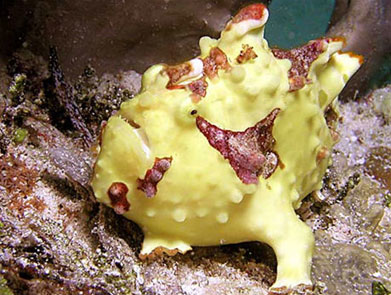
Frog Fish, Mantebuan Island
Scuba junkie provides dives to over 25 other islands in the area besides Sipadan. The mode of travel is 25-35 ft dive/speed boats powered by 2 huge outboard motors, easily cruising 35-40 mph. Most of the islands can be reached in less than an hour. We had some interesting dives around Mabul and Mantebuan Island. We saw schools of barracuda, bat fish, wrasses, trigger fish and reef fish of every variety imaginable. Macro life such as rainbow eels, ghost pipe fish, nudibranchs, and frog fish. The waters around these islands are generally calm and many shades of aqua blue. There are quite a few fish farms on the way, with mostly submerged fences making it look like a sea version of farmland. The last two days were spent diving around Sipidan. This island is small, but picturesque, rising over 2,000 feet from the seabed. Located in the southeastern tip of Sabah, it was formed by living corals growing on top of an extinct volcano that took thousands of years to develop. Situated in the heart of the richest marine habitat on Earth, more than 3,000 species of fish and hundreds of varieties of coral have been classified in this ecosystem. The highlight of our dive trip was our last day at Barracuda Point. Time seemed to stop in this other worldly environment. A vertical wall plunges thousands of feet into the dark blue depths of the ocean, raked mercilessly by fast currents that serve up a buffet of food for the local fish populations. HUGE schools of big eyed jacks, mackerel, tuna and chevron barracuda effortlessly feasted and meandered by. There also seemed to be an endless procession of large grey reef and white tip sharks,(5-7ft in length) plus countless turtles listlessly parading by without a care in the world. It was cloudy and raining on the surface during our dive, making the undersea world murky and even more otherworldly. Sharks gradually came into form out of the dark blue murk of the deep. It was one of the most amazing things I have ever witnessed.
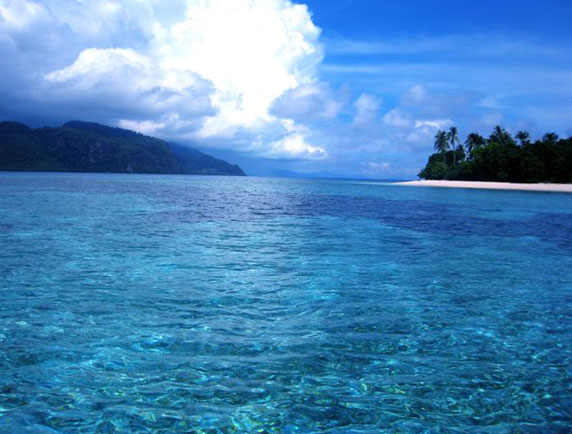
Mantebaun Island
Seporna night life is a little lacking, but the Scuba Junkie’s bar has something happening every night, ranging from quiz night, to local bands. We even got to witness a very entertaining dive master graduation culminating in a snorkel drinking contest. We discovered “roti” at a Malay Indian Restaurant two doors down from the Hostel. Roti is similar to a crepe and filled with a large variety of things; chocolate, curry, bananas, chicken or seafood.
Our 5 days here passed in a flash and the next thing we knew we were off in our rented 4 x 4 Toyota Land Cruiser to downtown Tawau. We stayed at the Kings Park Hotel. It had modern, spotlessly clean rooms and hot water, which was a welcome treat.
That night we rearranged our packs and got additional supplies for our 5 day trek into the mysterious Lost World of Maliau Basin. This jungle wilderness is located in the mountain highlands about 180km northwest of Tawau. It is easily distinguished by its circular perimeter, flanked on all sides by cliffs towering up to 4700ft in height. Because of the very dense vegetation and extreme topography, the basin is almost inaccessible by foot. The rocks here are sedimentary formations comprised mainly of sandstone, silt, and mudstone. This area has the greatest concentration of waterfalls in Southeast Asia—and that’s saying something.
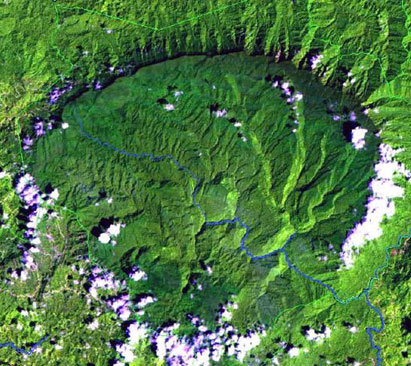
Satellite photo of Maliau Basin
Discovered officially by a pilot who almost crashed here in 1947, it was not until 1988 that the first major scientific expedition took place in the Maliau Basin. The area has never been permanently settled. As of 2007, only 25% of the basin had been explored and only ten percent had been actively studied. Over 1,800 species of plants, 270 types of birds, and 82 kinds of animals live here. It seemed like over a trillion insects occupy the area, including the aggressive blood sucking and ever dreaded brown tiger leech –I’m not making that up. Roughly 2300 visitors have come to the park in the past 8 years, and 5 have been Americans. (Steve and I were numbers 4 and 5)
The first day, we left with our driver Romley, in a Toyota Land cruiser for the 5 hour journey to the Basin. For the first couple of hours, we drove along smooth two lane paved roads winding thru the rolling green countryside of seemingly endless palm oil plantations. The pavement then gave way to a wide gravel logging road, flanked by secondary growth rainforest. Then it became a narrower utility road, clawing its way through ever increasing and less disturbed tropical forest. By the end of the drive, we were inching our way on a muddy bulldozer path through virgin jungle to our camp.
Agathis Base Camp had breezy, well ventilated dorm beds with mosquito nets and a comfortable common area right next to a stream and small waterfall. The misty, vibrantly green forest created an energy that was both exciting and relaxing at the same time. Waterfalls, insects, birds, and gibbons combined to create a spine tingling and loud chorus that did not seem to belong to this earth. There was also the hypnotic sound of the rain hitting the tin roof, with the drip drip of water hitting the ground in the low areas. We had nothing better to do but take it all in while flipping through a collection of news and magazine articles the park officials had saved over the years about the discovery, exploration, and research of the LOST WORLD of Maliau Basin.
Our first hike was a very challenging four hours to Camel Trophy camp. First, the humidity is almost 100%, with temperatures in the mid 80s. Within ten minutes of walking, we were soaked to the core with sweat. The trail immediately took us up a steep incline interspersed with climbing ropes and ladders, creating an added challenge, especially with 30lbs on our backs. The smells of the rainforest were a combination of oxygen rich fresh green growth and a hint of rotting leaves in the fall. All things here are doing one of two things; either growing or decaying. Built in 1993, Camel Trophy camp is a two story complex with an airy open common area adjacent to a basic kitchen. It has dorm style rooms for about 20 on the second floor. There were three shared bathrooms/showers around back. After taking a couple of hours to wash our clothes and remove leeches, we headed off on a three hour hike to Giluk and Takob-Akob falls. Reaching the falls required a treacherously steep climb down, with ladders to assist our descent. We were rewarded with a front row seat to a 75 plus ft waterfall set among some of the most lush vegetation imaginable.
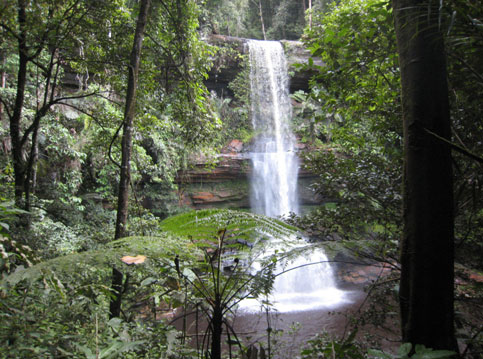
The next morning, we left early in an effort to avoid the afternoon rain showers, which are prevalent in the area. Because the forest is so thick, there is usually no breeze except along the ridge lines. The wildlife throughout the basin is plentiful and easy to hear but hard to spot. We did see Gibbons and McCaw monkeys, barking deer, hornbills, bearded pigs, a 4 ft monitor lizard, some very scary spiders, and a ton of leeches. After 2 1/2 hours of hiking, we stashed our packs at a junction in the trail. From there, we headed down to Maliau falls. The trail was steep in places and became slick and muddy near the bottom. (sound familiar??) Maliau falls is the largest and most famous falls in the basin. We were awestruck by the volume of red/brown water that came thundering down from the ledge above. Our brief moment of peace and tranquility lasted only a short while as thunderclouds began to loom overhead.
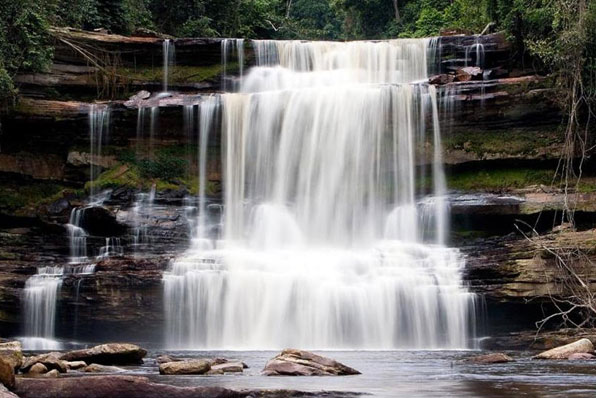
Maliau Falls
We hustled back to our packs and made our way to Ginseng camp. About a mile out of camp, the heavens opened up and a torrential downpour made the trail slippery and hazardous.
We arrived at Ginseng camp looking more like we had been wallowing in the mud than walking through it. We spent the next hour washing the mud/blood and leeches from our clothing, then cooked dinner, relaxed and readied ourselves for the following day. There was constant rain throughout the night, combined with the (now familiar) eerie night sounds of the jungle. Nature’s concert easily lulled us to sleep.
The next morning we left early, determined not to get caught in another afternoon rainstorm. We made our way to the Study Center Headquarters on a seldom used trail developed a couple of years ago. We found out later that only 4 other tourists had taken this trail and soon understood why….. This “trail” turned out to be little more than colored tape marking the way. We essentially bushwhacked through rugged virgin jungle covering less than 5 miles over the next 5.5 hours. The last two miles we descended over 1800ft, a descent requiring the constant use of ropes to keep us from a serious fall. Our guide Andy was incredible (actually a real life Tarzan), his ability to spot animals, avoid hazards and navigate the steep terrain without support was amazing. We finally made our way to the Maliau river, a welcome site and good place to cool off, strip down and pick leeches off our bodies/clothes. After resting an hour or so we made our way down river another half hour to our dorm room at the Conservation Center Headquarters…..Civilization yea!!! The past 4 days had pushed us to our limits both physically and mentally. This was the most intense trip I have ever been on. We felt very fortunate to have been able to forge our way thru one of the last true wildernesses in SE Asia and make it out safely–except for a few bruises, scrapes and 10 or so leech bites many of which were oozing a little blood. We also agreed that while the experience was extremely worthwhile, we were extremely glad it was over….taking a shower and sleeping in a bed without worrying about an uninvited guest is really underappreciated.
Borneo has had a long standing reputation of mystery and intrigue. There are legendary tribal headhunters who terrorized the jungle highlands at the turn of the 20th century. It’s also true that in 2001 twenty-one people were kidnapped in Sabah by Islamic terrorists from the nearby islands of southern Mindanao. This fueled many other rumors and fear has kept the less adventurous away. The area has become much more stable over the last 5 years (thanks to our US Special Ops in the Philippines) but the situation is fragile. For those who research well, have good street smarts and thrive on lessons of the unexpected, Borneo is a paradise. Get out of your comfort zone. Just dream it, plan it and do it. It’s there…and waiting for you.
See below for pics taken during the trip
BBC documentary Expedition Borneo (Part 1 and 2 30min each)
Many thanks to Kim Whiting and Steve Lundeen for their ideas, feedback and editing support
Stickman's thoughts:
Nice trip report.



